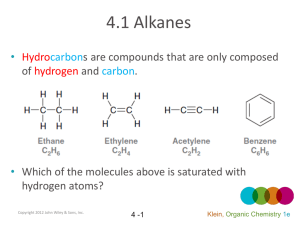

A suffix of - ol is added at the end of the name. To do so, determine the name of the alkane body (more on this later). There is a specific nomenclature used to describe alcohols. These reactions help facilitate substitution or elimination reactions in which an alcohol must be eliminated. Mesylate and tosylate reactions convert hydroxyl groups into mesylates or tosylates, which are good leaving groups. Additionally, hydroxyl groups can be converted into functional groups that are better leaving groups. Generally, chemists turn hydroxyl groups into ketones or aldehydes that become ketals/hemiketals or acetals/hemiacetals. This can be accomplished in several ways. Chemists perform these reactions to ensure the hydroxyl group does not react or interfere during the desired synthesis reaction. Since hydroxyl groups are able to lose a hydrogen ion in basic conditions, these substitution reactions proceed well when occurring in a basic solution.Īlcohols can also partake in protection reactions and mesylate/tosylate reactions.

In these reactions, the hydroxyl group can serve as a nucleophile, attacking a carbon center and creating a new molecule. There are specific reagents that can create aldehydes, ketones, and even carboxylic acids from an alcohol.Īlong with oxidation reactions, alcohols can participate in substitution reactions (Sn1 and Sn2 reactions). Alcohols can be converted into higher-level functional groups through oxidation reactions. This is an important property to consider because hydrogen bonding can raise the boiling points of many alcohols.Īlcohols also participate in many important synthesis reactions. Because alcohols possess a hydroxyl group with a hydrogen atom bound to an oxygen atom, they can participate in hydrogen bonding. Recall that hydrogen bonding relies on the interactions donated by hydrogens bound to other elements of high electronegativity (including oxygen, nitrogen, and fluorine). When this occurs, the hydroxyl group can now act as a nucleophile.Īlcohols can also participate in hydrogen bonding. Though they have a high pKa, alcohols are able to donate their protons in basic solutions. Alcohols can serve as weak Bronsted acids, with a pKa between 15 and 20.

One of the most interesting properties is their acidity. There are quite a few important properties that alcoholic functional groups have. Part 2: Oxygen-containing groups a) AlcoholsĪlcohols are molecules that contain a hydroxyl group, or -OH. (For a review of the function of electrophiles and nucleophiles, be sure to refer to our guide on the fundamentals of organic chemistry.) While the MCAT will rarely test you on nomenclature and molecular structure, general trends in electrophilicity, nucleophilicity, and electronegativity will be the most important information to retain for test day.Īt the end of this guide, there are also several AAMC-style practice questions for you to test your knowledge against. As you work through the guide, it will be most helpful to determine if these functional groups are electrophilic or nucleophilic. The sheer variety of functional groups can be overwhelming, but don’t worry if you aren’t familiar with them yet! This guide will review the major functional groups covered on the MCAT. After all, organic chemistry is all about the study of how molecules interact, and functional groups are collections of atoms that confer certain chemical properties to the molecule. To gain an understanding of organic chemistry, one must first gain an understanding of functional groups. Part 1: Introduction to functional groups


 0 kommentar(er)
0 kommentar(er)
